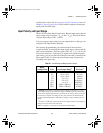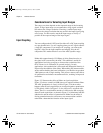
Chapter 3 Hardware Overview
PCI-6110E/6111E User Manual 3-4
©
National Instruments Corporation
Considerations for Selecting Input Ranges
The range you select depends on the expected range of the incoming
signal. A large input range can accommodate a large signal variation
but reduces the voltage resolution. Choosing a smaller input range
improves the voltage resolution but may result in the input signal going
out of range. For best results, match the input range as closely as
possible to the expected range of the input signal.
Input Coupling
You can configure the 611
X
E board for either AC or DC input coupling
on a per channel basis. Use AC coupling when your AC signal contains
a large DC component. If you enable AC coupling, you remove the
large DC offset for the input amplifier and amplify only the AC
component. This makes effective use of the ADC dynamic range.
Dither
Dither adds approximately 0.5 LSBrms of white Gaussian noise to
the signal to be converted by the ADC. This addition is useful for
applications involving averaging to increase the resolution of the
611
X
E board, as in calibration or spectral analysis. In such
applications, noise modulation is decreased and differential linearity is
improved by the addition of the dither. When taking DC measurements,
such as when checking the board calibration, you should average about
1,000 points to take a single reading. This process removes the effects
of quantization and reduces measurement noise, resulting in improved
resolution.
Figure 3-3 illustrates the effect of dither on signal acquisition.
Figure 3-3a shows a small (±4 LSB) sine wave acquired without dither.
The ADC quantization is clearly visible. Figure 3-3b shows what
happens when 50 such acquisitions are averaged together; quantization
is still plainly visible. In Figure 3-3c, the sine wave is acquired with
dither. There is a considerable amount of visible noise. But averaging
about 50 such acquisitions, as shown in Figure 3-3d, eliminates both the
added noise and the effects of quantization. Dither has the effect of
forcing quantization noise to become a zero-mean random variable
rather than a deterministic function of the input signal.
PCI_E.book Page 4 Thursday, June 25, 1998 12:55 PM


















